The Lawn Mulch Benefits in Lawn Care
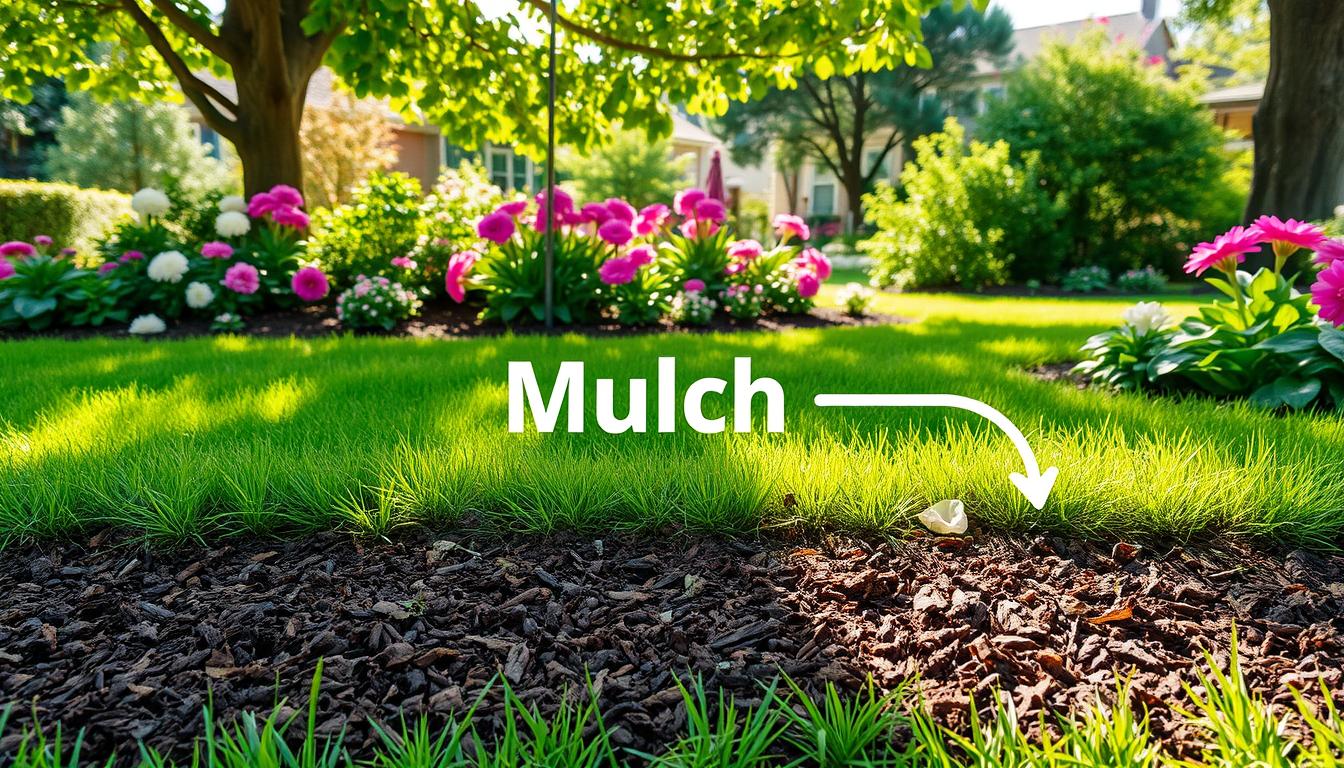
One of the biggest lawn mulch benefits is that it keeps your grass healthier by locking in moisture and reducing how often you need to water.
Did you know grass clippings are good for your lawn?
A 1,000 square foot lawn can get up to 4.8 pounds of nitrogen, 0.7 pounds of phosphorus, and 2.6 pounds of potassium each growing season. This is because of the natural recycling process that happens when you leave the clippings on the lawn.
I love gardening and taking care of my lawn. Mulching makes a big difference. It keeps the soil safe from rain, sun, and cold. It also helps keep moisture in and stops weeds from growing.
Using mulch is more than just making your lawn look good. It can also save you money by cutting down on water, fertilizers, and other lawn care needs. It also makes the soil healthier by supporting microbes and improving how it holds water and nutrients.
Key Takeaways
- Grass clippings return valuable nutrients like nitrogen, phosphorus, and potassium to the soil.
- Mulching helps protect soil from harsh weather conditions and retains moisture.
- Mulching can save money by reducing the need for water, fertilizers, and other lawn care products.
- Mulch improves soil health by promoting microbial activity and nutrient cycling.
- Mulching reduces the amount of yard waste that ends up in landfills, benefiting the environment.
What is Mulch and Mulching?
In lawn care, mulch is organic stuff like leaves or grass clippings. It’s spread on the soil to feed it and protect it. Mulching means covering the soil with this organic material. It makes your lawn healthier and more vibrant.
Mulch: The Organic Matter for Soil Nourishment
Using mulch is not only about keeping your lawn neat—lawn mulch benefits go beyond appearance, adding nutrients back into the soil and reducing the need for extra fertilizers.
Wood-based mulches are top picks for better soil. Scotts® Nature Scapes® Color Enhanced Mulch and Scotts® Nature Scapes® Triple Shred Mulch are great. They’re made from natural wood and last up to a year. They add color and nutrients as they break down.
The Process of Mulching: A Protective Soil Cover
Mulching creates a 2 to 3-inch layer of organic material on the soil. This layer does many things, like:
- Blocking sunlight to stop weeds
- Keeping soil temperature right for plants
- Keeping moisture in and watering less often
- Adding nutrients as it breaks down
- Stopping erosion from water and rain
Mulching makes your lawn care better. It uses nature to feed your soil and help plants grow. This leads to a strong, healthy lawn.
“Mulch acts as an insulator, regulating soil temperature to keep plant roots cool in the summer and warm in the winter.”
Cost-Saving Benefits of Mulching
Among the many lawn mulch benefits, the natural weed prevention stands out, as the mulch layer blocks sunlight and helps keep weeds from taking over.
Keeping your lawn healthy doesn’t have to cost a lot. One smart way to save money is by mulching your lawn clippings. This method helps you use less expensive fertilizers, saving you money over time.
Recycling Nutrients: A Natural Fertilizer Alternative
Fertilizers can be pricey, but mulching your grass clippings is a cheaper option. It adds nutrients like nitrogen and potassium to your soil. This natural method not only saves money but also makes your grass healthier and greener.
- Mulching controls lawn thatch by boosting microbial activity. This helps break down thatch and reduces the need for weed control products.
- Organic mulches improve soil texture and condition. They reduce soil compaction and attract beneficial microbes and insects, improving soil health.
- Mulch protects soil from the sun, reducing evaporation. This keeps the soil moist longer, saving water and lowering your water bills.
Mulching is a smart choice for a lush, vibrant lawn without breaking the bank. It’s a cost-effective and eco-friendly option that benefits both your wallet and the environment.
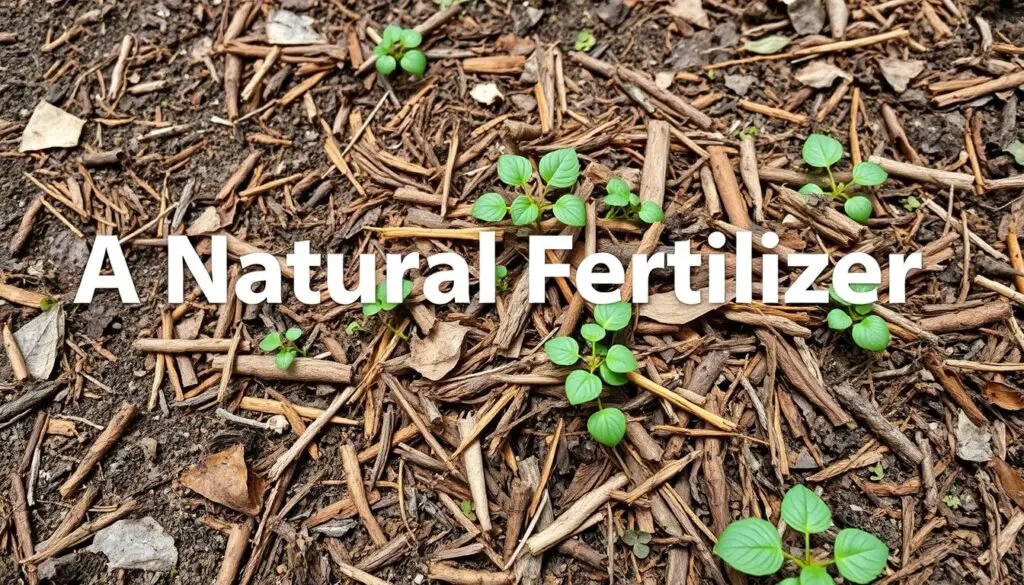
“Mulching is a game-changer in lawn care, providing a natural and cost-effective way to nourish your grass while minimizing the need for expensive treatments. It’s a simple step that can make a big difference in your budget.”
Lawn Mulch Benefits For Your Lawn
If you’re looking to cut back on lawn care costs, lawn mulch benefits include saving on water, fertilizer, and other products while promoting a healthier, more sustainable lawn.
Adding lawn mulch to your yard care routine can greatly benefit your grass and soil. As a gardener, I’ve seen how mulch can make a lawn lush and healthy. It enriches the soil and keeps it moist, offering many advantages.
Grass clippings as mulch provide essential nutrients like Nitrogen, Potassium, and Phosphorus at a natural level compared to chemical additives. Using grass clippings as mulch helps keep the soil moist. It also cools the soil and promotes healthier soil through humus formation. This method saves money and helps reduce waste by recycling natural materials.
Key Benefits of Lawn Mulch
- Temperature Regulation: Mulch keeps the soil cool in warm months by shading and insulating it.
- Soil Moisture Retention: Mulch reduces soil evaporation, helping plants stay hydrated.
- Soil Erosion Prevention: Mulch protects the soil from erosion during bad weather.
- Weed Control: Mulch blocks sunlight and weeds, preventing them from growing.
- Soil Structure Improvement: As mulch breaks down, it improves soil structure in clay and sandy soils.
- Soil Health Enhancement: Organic mulches add organic matter, attracting beneficial insects and microbes.
- Growing Season Extension: Mulch traps heat in cold months, extending the growing season.
- Disease Prevention: Mulch reduces splashes on leaves, lowering disease risk.
Using lawn mulch can turn your outdoor space into a lush oasis. It needs less care and offers long-term benefits for your grass and soil. As a lawn care expert in Dallas, I suggest mulching to improve your lawn’s health and beauty.
Lawn Thatch Control Through Mulching
Mulching your lawn doesn’t add to thatch buildup. Instead, it boosts microbial activity, which breaks down thatch. Regular mowing and mulching keep this activity high and thatch levels in check.
Bagging grass clippings means losing nutrients that could enrich the soil. It also causes soil compaction, harming root growth and water absorption. Bagging also messes with soil structure and fertility.
Mulching, on the other hand, promotes healthy grass and fights weeds and pests. But, too much mulch can smother grass and cut off oxygen. The goal is to keep a thin layer of mulch that benefits your lawn.
Robotic lawn mowers are great at reducing thatch. They make a mulch that decomposes well, unlike traditional mowing methods that can lead to thatch buildup.
In short, mulching regularly helps break down thatch and feeds your grass. It’s a green way to keep your lawn healthy and looking good.
| Bagging Grass Clippings | Mulching Grass Clippings |
|---|---|
| Helps neaten the lawn and make it look more well-kept | Prevents weeds and improves lawn drainage |
| Can help with lawn pests like grubs and chinch bugs | Promotes healthier grass |
| Can reduce thatch build-up | Can contribute to thatch build-up if done excessively |
| Deprives the lawn of valuable nutrients when clippings are not recycled back into the soil | Provides the lawn with essential nutrients as the clippings decompose |
Mulching Improves Lawn Health
From protecting the soil to promoting plant growth, lawn mulch benefits your yard in so many ways, making it a smart choice for a thriving, low-maintenance lawn.
Many homeowners want a lush, vibrant lawn. Mulching can make your grass healthier. As mulch breaks down, it feeds earthworms and other good bugs. This boosts the lawn mulch benefits and mulching lawn benefits.
Nutrient Availability and Microbial Activity
More bugs mean healthier soil. This soil gives your grass the nutrients it needs. It also fights weeds and diseases, saving you money on treatments.
Weed and Disease Resistance
Mulching stops weeds and pests, making your lawn strong. It keeps the soil moist and the temperature steady. This is great during hot summers or cold weather.
| Mulching Benefits | Impact on Lawn Health |
|---|---|
| Nutrient Availability | Improved soil fertility and grass growth |
| Microbial Activity | Enhanced soil biodiversity and overall soil health |
| Weed and Disease Resistance | Reduced need for chemical treatments and healthier lawn |
| Moisture Retention | Better water absorption and drought tolerance |
| Temperature Regulation | Moderated soil temperatures and stress-resilient grass |
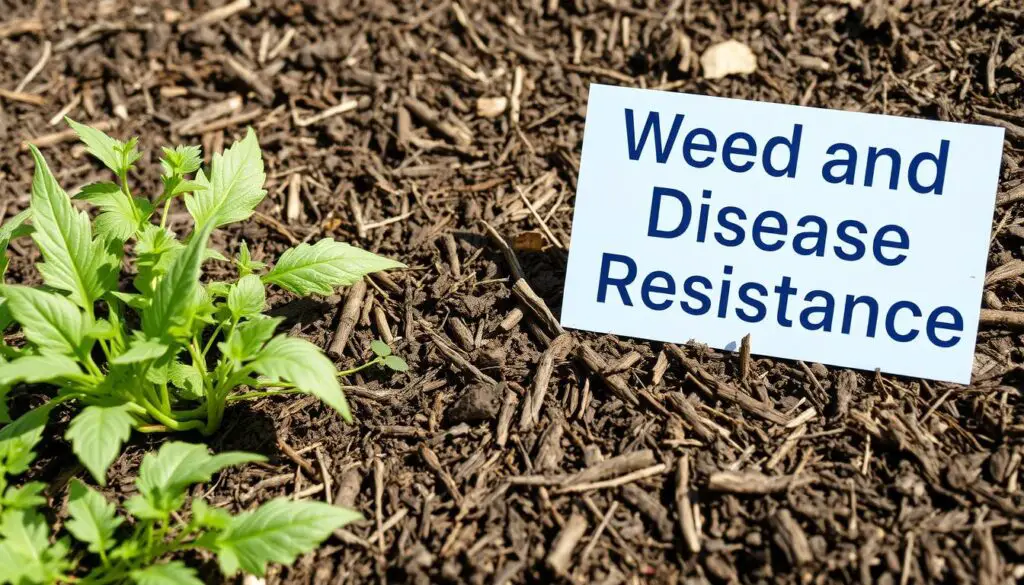
Mulching makes your lawn look great and stay healthy. It’s not just about looks. Mulching lawn benefits also save you money and make your outdoor space better.
Environmental Benefits of Mulching
Mulching grass clippings into your lawn is good for the grass and the environment. It keeps grass clippings out of landfills, which reduces waste and saves landfill space. In 2015, yard trimmings like leaves made up nearly 35 million tons of waste, with almost 11% going to landfills. Mulching is a green way to keep this organic material out of landfills.
Mulch also helps the soil and saves water. Mulching can cut water evaporation by up to 70% in hot summers, keeping lawns and gardens moist. It also stops weeds by blocking sunlight and smothering weed seeds. As it breaks down, mulch adds nutrients like nitrogen and phosphorus to the soil, making it healthier.
Plus, mulch is often made from organic stuff like wood chips and leaves. This reduces landfill waste and cuts down on the need for chemical fertilizers and pesticides. So, mulching is a greener choice for lawn care.
“Mulching is a sustainable solution that helps divert organic material from ending up in landfills.”
In summary, mulching offers many environmental benefits. It reduces waste, saves water, improves soil, and supports green practices. Mulching is a key tool for making your lawn and garden more eco-friendly.
Best Practices for Mulching Grass
Proper lawn mulch application and maintenance are key to achieving optimal results in your yard. By following the right techniques, you can unlock the full benefits of mulching and maintain a lush, healthy lawn.
Optimal Timing and Grass Length
For the best lawn mulch application, mow when the grass is dry. This is usually in the afternoon after the morning dew has evaporated. Cut the grass to a length of no shorter than two-thirds of its original height, and no less than three inches.
This ensures the grass clippings are finely shredded. They can easily decompose, releasing valuable nutrients back into the soil.
Mower Deck Maintenance
Regular maintenance of the mower deck is crucial for effective mulching. Debris buildup can disrupt the airflow necessary for the mower to evenly distribute the grass clippings. Sharpening the mulching blades frequently also helps ensure the grass is cut into fine, decomposable particles.
This promotes faster nutrient recycling.
| Mulching Tip | Benefit |
|---|---|
| Mow when grass is dry | Finely shredded clippings decompose faster |
| Keep grass at 2/3 to 3 inches height | Promotes even distribution of clippings |
| Maintain mower deck and sharpen blades | Ensures efficient mulching for nutrient recycling |
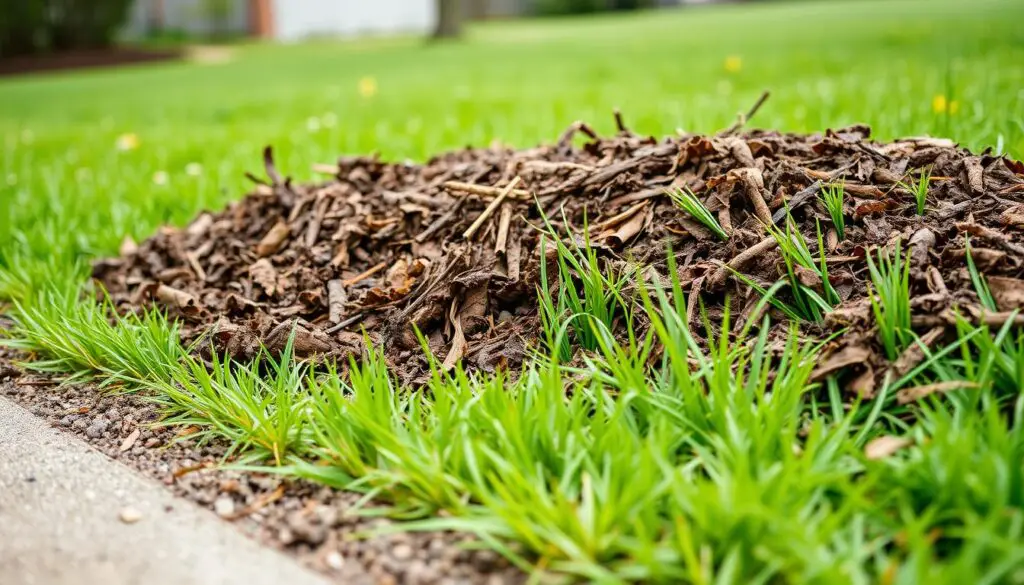
By following these best practices for lawn mulch application and lawn mulch maintenance, you can maximize the benefits of mulching. This will help maintain a thriving, nutrient-rich lawn all season long.
When Not to Mulch Grass Clippings
Mulching your lawn has many benefits. But, there are times when it’s not the best choice. Knowing when not to mulch is key to keeping your lawn healthy and looking good.
Weed-Infested Lawns
Mulching a lawn with weeds can spread weed seeds. This makes the problem worse. It’s better to bag the clippings until the weeds are gone. This stops weed seeds from spreading and growing in your lawn.
Pesticide or Fertilizer Applications
After using pesticides or fertilizers, mulching might not work well. These chemicals can harm the good microbes that break down mulch. Wait a bit before mulching to let the chemicals work first.
Mulching is usually good for your lawn. But, there are times when it’s not the best choice. Knowing when to skip mulching helps keep your lawn healthy and looking great.
| Scenario | Recommended Action |
|---|---|
| Weed-infested lawn | Bag and remove grass clippings until weeds are under control |
| Recent pesticide or fertilizer application | Avoid mulching for a period of time to allow chemicals to take effect |
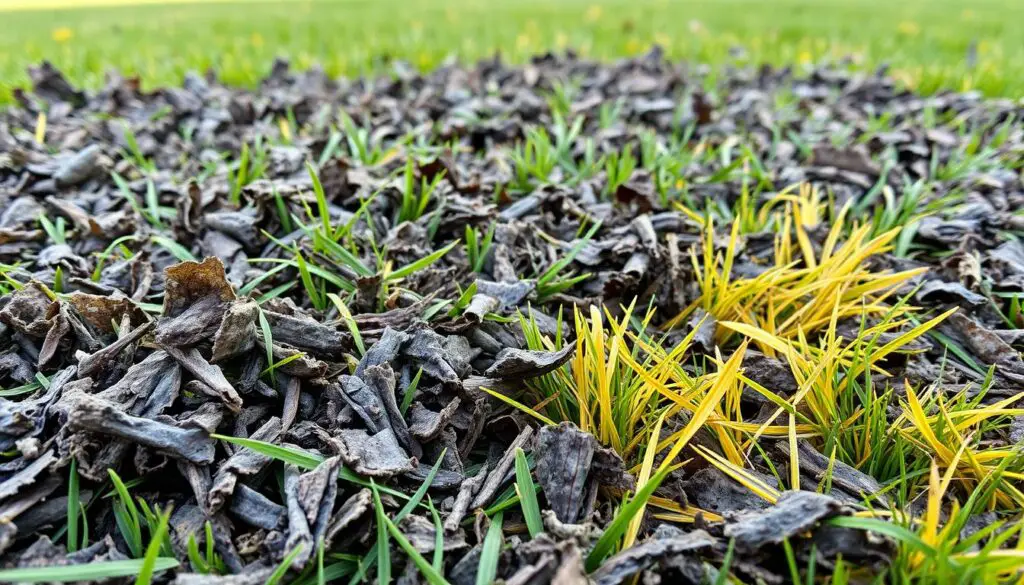
Being aware of these situations helps keep your lawn healthy and vibrant. Even when mulching isn’t the best choice, your lawn will still look great.
Mulching Equipment and Supplies
Keeping your lawn looking great is easier with the right tools. You’ll need a lawn mower that can mulch, like one with special blades and a deck baffle system. These help chop grass clippings finely and spread them evenly back into the lawn. This gives your grass the nutrients it needs to stay healthy.
For mulching kits, including blades and baffles, visit your local Ariens dealer or the Ariens online parts store. Keeping your mower’s mulching parts in good shape is key to a lush lawn.
Lawn Mulch Equipment
- Lawn mower with mulching capabilities
- Mulching blades
- Deck baffle system
- Mulching kits from authorized dealers
Lawn Mulching Supplies
- Organic mulch materials (e.g., wood chips, pine bark, fallen leaves)
- Mulch spreaders or broadcasts
- Rakes and shovels for application
- Protective equipment (gloves, eye protection)
| Mulch Type | Characteristics | Benefits |
|---|---|---|
| Wood Chips | Relatively inexpensive, easy to install | Absorb moisture, suppress weed growth, improve soil health |
| Pine Bark | Durable, long-lasting, attractive appearance | Retain moisture, discourage pests, enhance soil structure |
| Rubber Mulch | Non-flammable, come in various colors | Flexible landscaping designs, retain heat for cold climates |
Getting your mulch ready and applying it right is crucial. First, remove weeds and debris, aerate the soil, and fertilize for healthy grass. Spread the mulch evenly, about 2-3 inches thick, but avoid touching plant stems or trunks. With the right lawn mulch equipment and lawn mulching supplies, your lawn will become a lush, low-maintenance oasis.
Mulching: A Sustainable Lawn Care Solution
Keeping your lawn healthy doesn’t have to cost a lot or harm the planet. Mulching is the key. It turns your grass clippings into nutrients, cutting down on chemical fertilizers and saving money. Mulching also fights lawn thatch, boosts soil health, and keeps weeds and diseases away. It’s a green way to care for your lawn.
Mulching can turn your lawn into a lush paradise. Mulching your lawn feeds the soil and keeps it stable. This protects your grass from harsh weather. As the mulch breaks down, it adds vital nutrients to the soil, helping your lawn grow strong.
Mulching is great for saving time, money, and the environment. Adding mulching to your lawn care routine can make your lawn the best on the block. So, give it a shot and see the many benefits for yourself.
FAQ
What are the benefits of using mulch in lawn care?
What is mulch and the process of mulching?
How can mulching save me money on lawn care?
How does mulching improve lawn health?
Does mulching contribute to lawn thatch build-up?
What are the environmental benefits of mulching?
What are the best practices for mulching grass?
When should I avoid mulching grass clippings?
What equipment and supplies do I need for mulching?
Source Links
- https://www.lawnstarter.com/blog/lawn-care-2/reasons-to-use-grass-clippings-as-mulch/
- https://www.ariens.com/en-us/company/blog/316/benefits-of-grass-mulching
- https://www.spsonline.com/blog/benefits-mulching-garden/
- https://scotts.com/en-us/lawn-care-101/the-benefits-of-mulching-how-to-pick-the-right-type-of-mulch-material.html
- https://www.homedepot.com/c/ai/benefits-of-mulch/9ba683603be9fa5395fab901dfafd55
- https://lawnlove.com/blog/mulch-benefits/
- https://gomow.com/blog/can-mulching-save-you-time-and-money-in-your-lawn-care-routine-in-san-antonio-tx/
- https://www.yandllandscaping.com/blog/the-benefits-of-mulching
- https://executivelawncare.net/2020/09/30/benefits-mulching-grass-clippings/
- https://homesteadersofamerica.com/8-benefits-of-mulch-in-the-garden/
- https://www.lawnandpest.net/blog/bagging-or-mulching-the-pros-and-cons/
- https://www.littlejohnslawns.com/blog/mulching-vs-bagging-your-grass-clippings
- https://www.belrobotics.com/en/blog/maintain/preventing-thatch/
- https://lawnlove.com/blog/benefits-of-a-mulching-lawn-mower/
- https://www.lawnweedexpert.co.uk/news/post/mulching-what-is-it-and-what-are-the-benefits
- https://premierfinishes.net/blogs/news/the-environmental-benefits-of-mulch?srsltid=AfmBOoqyqDLHp_GGYRi9GuwKYH_zKZCMgfPpBIo4s_0ck3n0dwboNdMY
- https://bnrc.springeropen.com/articles/10.1186/s42269-020-00290-3
- https://lenz-enterprises.com/mulch/the-4-main-benefits-of-mulch/
- https://todayshomeowner.com/lawn-garden/guides/how-to-mulch-with-grass-clippings/
- https://www.turfunlimited.com/2024/05/27/the-art-of-mulching-benefits-and-techniques-for-a-healthy-lawn/
- https://www.hutsoninc.com/blog/mulching-vs-bagging/
- https://www.thespruce.com/mulch-grass-clippings-back-into-lawn-2152861
- https://www.oneilllandscapes.com/blog/is-it-better-to-bag-or-mulch-your-grass-clippings-when-mowing-your-lawn
- https://edis.ifas.ufl.edu/publication/EP626
- https://www.oneneighbor.com/blog/mulch-installation-benefits-materials-and-colors-explained
- https://news.vt.edu/articles/2023/10/CALS_fall_lawncare_experts.html
- https://www.cleangreenlawnteam.com/lawn-care-tips/the-benefits-of-mulching
- https://www.trimlinelandscape.com/blog/protect-your-lawn

